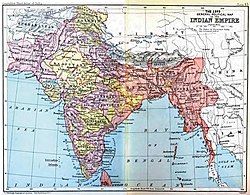British Empire in India
|
||||||||||||||||||
| Imperial political structure comprising (a) British India (a quasi-federation of presidencies and provinces directly governed by the British Crown through the Viceroy and Governor-General of India); (b) Princely States, governed by Indian rulers, under the suzerainty of the British Crown exercised through the Viceroy and Governor-General of India |
||||||||||||||||||
|
||||||||||||||||||
|
||||||||||||||||||
|
Anthem God Save the King/Queen |
||||||||||||||||||
|
The British Indian Empire in 1936.
|
||||||||||||||||||
| Capital | ||||||||||||||||||
| Languages | (official) | |||||||||||||||||
| Government | Colony | |||||||||||||||||
| Monarch of the United Kingdom and Emperor/Empressa | ||||||||||||||||||
| • | 1858–1901 | Victoria | ||||||||||||||||
| • | 1901–1910 | Edward VII | ||||||||||||||||
| • | 1910–1936 | George V | ||||||||||||||||
| • | 1936 | Edward VIII | ||||||||||||||||
| • | 1936–1947 | George VI | ||||||||||||||||
| Viceroy and Governor-Generalc | ||||||||||||||||||
| • | 1858–1862 | (first) Charles Canning | ||||||||||||||||
| • | 1947 | (last) Louis Mountbatten | ||||||||||||||||
| Secretary of State | ||||||||||||||||||
| • | 1858–1859 | (first) Edward Stanley | ||||||||||||||||
| • | 1947 | (last) William Hare | ||||||||||||||||
| Legislature | ||||||||||||||||||
| History | ||||||||||||||||||
| • | Battle of Plassey | 23 June 1757 | ||||||||||||||||
| • | Government of India Act | 2 August 1858 | ||||||||||||||||
| • | Indian Independence Act | 15 August 1947 | ||||||||||||||||
| • | Partition of India | 15 August 1947 | ||||||||||||||||
| Area | ||||||||||||||||||
| • | 1937 | 4,903,312 km² (1,893,179 sq mi) | ||||||||||||||||
| • | 1947 | 4,226,734 km² (1,631,951 sq mi) | ||||||||||||||||
| Currency | Indian rupee | |||||||||||||||||
|
||||||||||||||||||
| Today part of | ||||||||||||||||||
| a. | Title existed 1876–1948. | |||||||||||||||||
| c. | Full title was "Viceroy and Governor-General of India". | |||||||||||||||||

Imperial entities of India
|
|
| Dutch India | 1605–1825 |
|---|---|
| Danish India | 1620–1869 |
| French India | 1769–1954 |
|
|
|
| Casa da Índia | 1434–1833 |
| Portuguese East India Company | 1628–1633 |
|
|
|
| East India Company | 1612–1757 |
| Company rule in India | 1757–1858 |
| British Raj | 1858–1947 |
| British rule in Burma | 1824–1948 |
| Princely states | 1721–1949 |
| Partition of India |
1947
|
|
|
|
The British Raj (/rɑːdʒ/; from rāj, literally, "rule" in Hindustani) was the rule of the British Crown in the Indian subcontinent between 1858 and 1947. The rule is also called Crown rule in India, or direct rule in India. The region under British control was commonly called India in contemporaneous usage, and included areas directly administered by the United Kingdom, which were collectively called British India, and those ruled by indigenous rulers, but under British tutelage or paramountcy, and called the princely states. The resulting political union was also called the Indian Empire and after 1876 issued passports under that name. As India, it was a founding member of the League of Nations, a participating nation in the Summer Olympics in 1900, 1920, 1928, 1932, and 1936, and a founding member of the United Nations in San Francisco in 1945.
This system of governance was instituted on 28 June 1858, when, after the Indian Rebellion of 1857, the rule of the British East India Company was transferred to the Crown in the person of Queen Victoria (who, in 1876, was proclaimed Empress of India). As a state, the British Empire in India functioned as if it saw itself as the guardian of a system of connected markets maintained by means of military power, business legislation and monetary management. It lasted until 1947, when the British Indian Empire was partitioned into two sovereign dominion states: the Dominion of India (later the Republic of India) and the Dominion of Pakistan (later the Islamic Republic of Pakistan, the eastern part of which, still later, became the People's Republic of Bangladesh). At the inception of the Raj in 1858, Lower Burma was already a part of British India; Upper Burma was added in 1886, and the resulting union, Burma, was administered as an autonomous province until 1937, when it became a separate British colony, gaining its own independence in 1948.
...
Wikipedia



